As an Amazon Associate I earn from qualifying purchases.
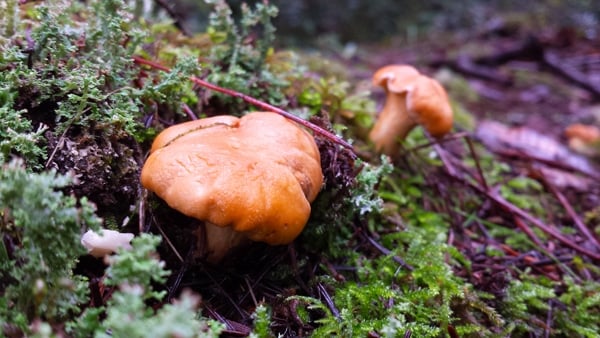
I awake somewhere near the midway point between dusk and dawn. Not night, but certainly not morning. The house is quiet. Even the cats are sleeping. I slide silently out of bed so as not to wake Holly, and stumble my way toward the kitchen, where Glorious Coffee awaits me. A glance out the window: fog. Lots of fog. Should be a fun drive today.
As I brush my teeth, I hear the Tolkein-esque rumblings of the coffee maker. How can such a small object make a noise like an ent, or a giant with gastric distress. My mind lingers on this for longer than it ought to. Need coffee.
I pull on a ratty pair of Wranglers, a wool thermal shirt and my favorite plaid shirt. I find that most men, and nearly all men of the outdoors, possess a favorite flannel shirt that is the sartorial equivalent of those “ugliest dog” contests. We love this shirt, even when it has partially rotted off us. Fashion be damned.
Gear check. Backpack, the same tattered Eastsport I’ve been hauling around for something longer than a decade. Knife? Check. Paper bags? Lots. Cloth bag? Yep. Plastic containers, with lids? Yep and yep. Water, venison jerky, a bag of nuts and a couple tangerines. Good to go.
I drop a dollop of honey into my coffee and stir. The steel on steel jangling always wakes Holly up, but she says it’s a reassuring sound, one she can easily fall back asleep to. I hope that’s not just a pleasant lie. I check the clock on the stove: 4:03 a.m. Time to go.
I fire up the old Tacoma. Just topped 340,000 miles, and still running great. I tap the handle of my knife so I don’t jinx myself. I grab an old Quail Forever cap, rimmed with salt from my last mushroom hunt, and check to be sure I have my waterproof goose hunting pants. It’s going to be wet today.
So begins what amounts to a commute for me in winter. On days I am not duck hunting or otherwise chasing God’s creatures (or trying to make a living), I point my truck in the direction of California’s North Coast in search of mushrooms. On years such as this one, where we’ve had rain, it can be a magical time of year.
In fall, porcini are king. In spring, it’s another round of porcini, plus the mighty morel. Summer is slim, time for fishing. But winter — winter! — can bring a vast array of edible mushrooms. The Holy Trinity are yellowfoot chanterelles, black trumpets and hedgehogs. These, plus matsutakes and the regular yellow and white chanterelles, are the mainstay of the winter mushroom season. But winter on the North Coast brings dizzying variety: Candy caps, saffron milk caps, pig’s ears, shrimp russula, edible amanitas — the grissettes and coccora — oyster mushrooms, blewits, fairy rings, meadow mushrooms, honey mushrooms, and probably a dozen more I am forgetting.
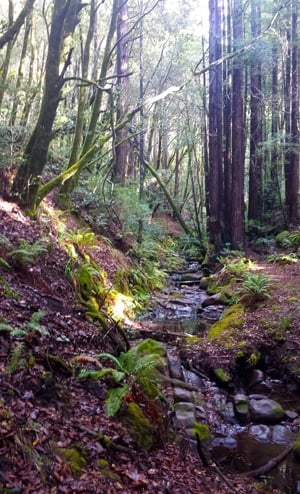
My spots range from Marin County all the way to Mendocino, 100 miles to the north. But I could, if I wanted to, range all the way to the Canadian border. The Pacific Northwest is a wonderland for mushrooms, even in winter. But I rarely go farther north; my drive is typically three hours or more each way already. And since I rarely spend the night in mushroom country, it makes for a long day, which is why I try to get to the grounds by dawn.
Interstate 80 can be full of cars even at 4:30 in the morning, if I am picking on a work day. I don’t envy that commute; I once had a similar one driving to and from the Capitol in Washington, D.C. from Virginia. The drive is always nastiest at a choke point where Highway 37 narrows to a single lane in Vallejo. Catch it right, and it’s a decent enough drive. Catch it wrong and it can add 45 minutes to an already long trip. Once I am through that, I head north on both highways and back roads, all the way to Bodega Bay. Then I turn north on California Highway 1, a harrowing road that routinely washes out in rainy winters. I never really know if I will be turned back by one as I drive.
Light begins to turn the Pacific from black to gray by the time I reach one of my better spots, Salt Point State Park. Salt Point is legendary among mushroomers, and even though it’s one of the few spots that everyone knows about, I rarely see more than a handful of other pickers in winter. Maybe the park’s five-pound limit keeps some away, maybe it’s the fact that the park is 6,000 acres and more than six miles long, with 20 miles of trails winding through it. It’s a big place.
The park is a maze of environments. Bishop pines, tanoak, manzanita, Douglas fir, even grasslands and scrub can be fruitful. Each mushroom likes a certain spot. I’ve learned this through years of picking, and from a few friends who’ve been picking this area longer than I have. Suffice to say that if I laid out which mushroom lives under which tree, they’d come and kill me.
I am only half joking. Mushrooming is an act so veiled in secrecy it makes hunting look open and inviting. I know of some old Italians who literally would not give away their spots until they were on their deathbed… and a couple not even then. Hardcore. I have a spot in Salt Point for giant hedgehogs, Hydnum repandum, so good I can pick my limit if I catch it right. My friend Jeff has one for black trumpets, Craterellus cornucopioides that is just as good. We know where each other’s spots are, but Mushroom Law states that neither of us go to the other’s spot without permission.
Identification can be something akin to wizardry, too — at least for uninitiated. Pick mushrooms long enough and your eye attunes to very slight details. I can easily spot the difference between the saffron milk cap, Lactarius deliciosus, and its kin, the bleeding milk cap, Lactarius rubrilacteus, without breaking stride; I happen to like both mushrooms. To many, these mushrooms are pretty damn close, as are the many grass-dwelling agaricus mushrooms. Several are nasty enough to be called the “lose your lunch bunch,” but a few, notably the meadow mushroom and the horse mushroom, are damn good. How to tell? Same way you get to Carnegie Hall: Practice, man, practice.

I stare at my windshield, watching rain pelt it. Going to be a wet one. I hope the rain slackens as it gets a little lighter, and I am rewarded for my patience; by 7:55 the rain weakens to a mist. Mist I can handle. I slip out of my truck and duck into the brush. For whatever reason I never like to let anyone see me when I am mushrooming. I will always make myself invisible when I am picking, if I can. I once had a couple, fellow mushroomers, walk no more than feet away from me, totally oblivious. By missing me, they also missed the massive flush of matsutakes at my feet.
I am looking for candy caps today. They are a cheery orange mushroom that, when you dry them, smell almost exactly like maple syrup. Trippy, eh? I like using candy caps for things like panna cotta, ice cream, baked goods — you know, sweet things. I’ve also powdered them and dusted wild boar loin with them, which is quite nice.
There’s one. And another. Candy caps like to be with each other, often halfway hiding under pine needles. You need to watch for a fuzzy white mold that forms on old ones: Get that in your basket and it can ruin the whole lot.
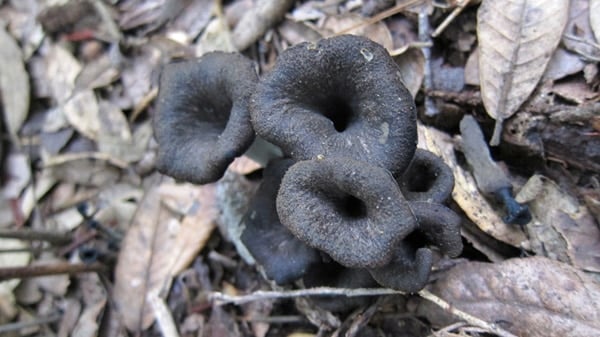
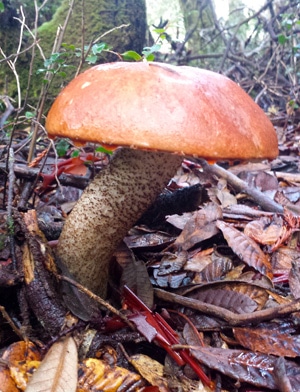
Soon I find a stretch of black trumpets. Where candy caps are usually nice and clean, the black trumpets are always dirty. They go into their own bag. That’s the way it is with the winter pick. A few of this species here, a few of that one there. I’ll often find a lone manzanita bolete hanging out where I find matsutakes. I like this mushroom, especially dried and in a pasta sauce, so I take them. I never find more than one, though, oddly.
I see lots of baby hedgehogs, a slow-growing mushroom that is gold once the chanterelles peter out in late winter. I’ve watched the same patch grow for a month — totally unlike zephyrs like shaggy manes or the edible amanitas, which can go from prime to wretched in a day.
I move down the road a few miles, to a spot that’s yielded hundreds of yellowfoot chanterelles in the past. December is a little early for them, but then everything is early this year. I have long since stopped trying to guess what “normal” is. I climb silently up the hill, listening to the birds and the boom of the Pacific against the sandstone cliffs of the shore, a half-mile away. The woods here are normally preternaturally quiet, so hearing the birds is a treat. I stop to pick up a saffron milk cap and hear a twig snap. Another picker? (For the merest micro-second, I think lion? But the moment passes. Never seen one in these parts.) No, it’s a blacktail doe with a yearling. They’d seen me, but hadn’t panicked.
I worked my way parallel to them, ambling slowly, eyes on the ground. This must be a common enough occurrence in the lives of these deer to not spook them. When I cast a glance their way a few minutes later they were still there. The yearling was eating a russula mushroom. I moved on.
The yellowfeet weren’t there. Too early for this spot, I guess. But there were four pretty shrimp russulae, which I picked. These mushrooms fry up crispy and actually do taste a but like shrimp. I never find lots of them, so they’re a sort of picker’s treat.
An hour goes by. Two. Three. I am a shadow slipping through the woods. I walk up on another deer, this one a little buck. I say, “Hey Buck, how’s it going?” He tenses, looks my direction, but soon relaxes. Again, I don’t walk right at him. I sideslip him along a ridge edge. He’s looking for something yummy, probably a lichen. I am, too, because along this ridgeline are golden chanterelles. I find them, gleaming like nuggets in a stream of green moss. So lovely to catch them so young! Our chanterelles here in California can grow monstrous; I’ve picked a few larger than a pound. These are mere buttons, perfect for the pan.
I am nearing my limit, but I want just a few more mushrooms. I’ve not picked too many matsutakes this year, although it’s been a good one. I like matsies, as the professionals call them, but I don’t love them. I know, to many that’s heresy. I like how they smell more than they taste, which is bland, squitchy and firm, squeaky almost. I do like them dried, however: They are one of a few secret ingredients in my fish broths.
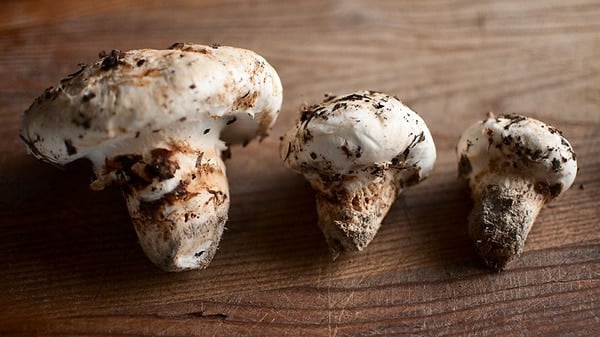
I happen to know that in this part of the world, the vaunted matsutake, which means “pine mushroom” in Japanese, does not favor pine. Our matsies prefer tanoak, and one other plant I dare not mention publicly. Find this combination in December and you should find your matsutakes. It took me almost an hour to find this magic combination, but when I did, I scored big time: Four perfect buttons (matsies that are not yet fully open, which makes them more aromatic), and another three that had already opened. Done.
Back at the truck, I strip off my soaked rain pants and jacket and peel a tangerine. The late December sky was already darkening. A long day. I turn my truck back toward Sacaramento for the three-hour trek back home. I’ll probably catch traffic and while the hours away listening to Pink Floyd, or the natterings of the sports radio talking heads.
I catch a whiff off something. It’s me, the sweat of a good day, plus something else: The perfume of a dozen kinds of wonderful mushrooms, mingling in the cabin of my truck.
I smile and breathe it all in. This is the best time of the year.


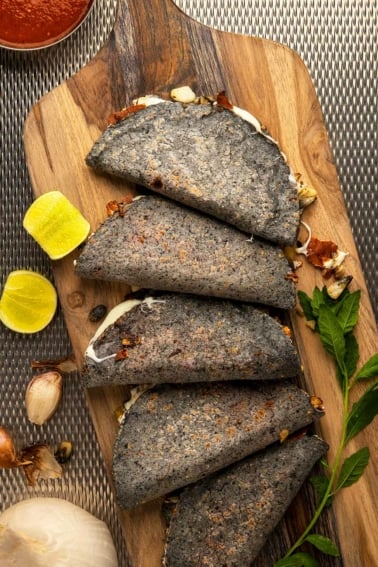

Hey Hank,
Do you think there are any mushrooms up the coast, now?
I might drive up and try my luck.
Is it to late in the season?
Thanks, Kevin
I just moved to Montana and am really wanting to get into the foraging game.. Any advice on spring time Foraging on the rocky mountain front?
Kent: Sure, there are lots of good foraging books that focus on the Rocky Mountains. I’d start there.
i have found a beautiful chanterella yellow with black gills, i live in California, how can i find the correct name for this species? if i email you a picture will you be able to help me define this beauty? thanks for this post, love your findings 🙂
cheers
DLG: Sure, can’t hurt. But I make no guarantees.
That was an excellent read.I really felt the excitement in your hunt.
Hey Hank,
Nice description of one of my fave places on the CA coast as well! But don’t relax over that “never seen a lion here, yet,” when you hear that next twig snap. Word from locals is that there are two females with cubs in that big park, one with territory to the south and one to the north. Stands to reason, in such a great and extensive habitat.
Just like you never hear the Prius that hits you, you seldom see the lion who is watching YOU! As long as you don’t bend over and squeal with delight at your mushroom finds, you’re good! 😉
And yes, I totally think that it’s worth it, lions or not. Off to hunt the wily morel!
Best to you,
Debbie Viess
Bay Area Mycological Society
Great article, Hank! If you ever need a sweet place to stay after a North Coast foraging day, you’d be most welcome at our home in Comptche!
Our li’l beauty claims she does not like mushrooms. So, last night, I sneaked one onto her fork when she wasn’t looking and popped it into her mouth before she noticed. Then I told her what I had done, to which she replied, “See, Mommy, I told you I love mushrooms.”
Hank, I so enjoyed reading this post. I felt like you took us all along for some mushroom-hunting!
Hank – loved this account of your day out mushrooming. Strangely enough, though I’m from Seattle, I didn’t catch the mushroom hunting but until I moved to Finland – where the “Every man’s right” means you can literally pick mushrooms wherever you find them as long as it isn’t directly in someone’s yard, and where there is no limit to the amount you are allowed to take home – good thing with the bumper crop of porcini this Fall! The only thing left standing this time of year are the few yellow foot chanterelles that haven’t succumbed to the cold of winter. I could almost hear the winds in the pines and feel the moss underfoot with this story – it’ll tide me over until the mushrooms rise again in these parts come May. – Ann
We Midatlantic, NE’ and & Midwestern folk will have to live vicariously for a few months off this article until we start to see some morels in the springtime. Some year I will get out to the left coast to see what you guys are talking about.
Nice write up! Its drying up quick at the coast, everything is slowing down and drying out. Two weeks ago it was perfect and now its crunchy out there! The Park has been getting a lot of pressure too (a few recent garbage regional paper write ups and Myco Club Forays), its taking longer to limit out. Might want to make the drive soon or wait until we get another rain (if we get another rain).
This winter has been one of the best mushroom seasons I can remember. I am fortunate to live directly adjacent to Salt Point Park and this is the only time of the year that anyone uses the park. The last few weeks have been full of hedghogs, matsutakes, black chantrelles, and a lot of other edibles. The cold weather this week may put that to an end, but we will see.
Been mushrooming for about six years here in the Central Valley and foothils and definitely smitten. Missed out on finding morels after the big fire seasons of 2012 and 2013. With another big fire season in 2014, do you care to speculate when one might begin to look up in the foothills in some of the burned areas for 2015?
I’m right up the road from you, in Loomis.
Thanks
Sorry Hank, after reading my post, it came across way more negative then I intended it. I really have to get out there and do it.
Wayne: I learned from lots of sources. Other people, guidebooks, and yes, the internet. Start picking mushrooms and work to ID them. Helps a lot! And, depending on where you live, I can recommend a guidebook, perhaps.
The learning curve on picking mushrooms is what scares most of us away from the activity. You eat the wrong one and you’re dead. How do you learn the different edible mushrooms without either a backpack full of books or having someone like you, who knows, show us. As a child I remember my Dad taking my Sister and me to a ranch in Folsom and picking “Field or Horse mushrooms” and the only thing he told us is take the ones with a pink underside and leave the ones with a white underside.
Wayne: It really isn’t rocket science, but yes, you do need to do a bit of studying and be attuned to details. I find that anyone who really wants to learn this skill can do so quite easily.
Awesomeness!
awesome article, thank you-
and, it leaves me so hopeful-
The picking sounds great, but the long drive and the traffic would not appeal to me at all. Here in northern Michigan, we don’t have the variety of edible mushrooms you have out there, but I only have to go a few miles from home to find them (in Sept/Oct, mostly). I rarely pass more than a few cars along the drive. And there is no limit on the amount you can pick. My favorite are the oyster mushrooms, but I also pick shaggy manes, puffballs, and honey mushrooms (Armillaria). In some years, I get a few morels in the spring also. We dry most of the oysters, and enjoy them all winter long.
If you ever go picking across the Canadian border (north past Vancouver and into the coastal mountains), you should add some form of bear protection to your picking equipment. Standalone bear bangers and spray are handy enough, although others prefer a short 12 ga.
This was a really nice article to read this morning. It made me miss the North Coast- a lot.
Rick Bayless has a recipe for Wild Mushroom Queso Fundido, which uses porcini mushrooms. With all of your mushroom foraging experience, what would you use in place of porcini to make the recipe your own?